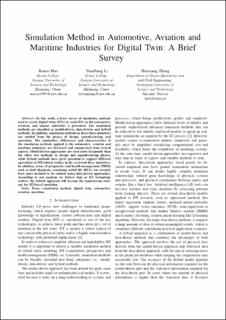| dc.contributor.author | Mao, Runze | |
| dc.contributor.author | Li, YuanJiang | |
| dc.contributor.author | Zhang, Houxiang | |
| dc.date.accessioned | 2024-02-05T12:48:55Z | |
| dc.date.available | 2024-02-05T12:48:55Z | |
| dc.date.created | 2023-12-19T09:03:01Z | |
| dc.date.issued | 2023 | |
| dc.identifier.isbn | 979-8-3503-1220-1 | |
| dc.identifier.uri | https://hdl.handle.net/11250/3115633 | |
| dc.description.abstract | In this work, a brief survey of simulation methods used to create digital twins (DTs) or assist DTs in the automotive, aviation, and marine industries is presented. The simulation methods are classified as model-driven, data-driven, and hybrid methods. In addition, simulation methods in these three industries are studied from the phases of design, manufacturing, and operation. The similarities, differences and characteristics of the simulation methods applied to the automotive, aviation and maritime industries are discussed and summarized from several aspects. Model-driven approaches are used more frequently than the other two methods in design and manufacturing phases, while hybrid methods have great potential to support different operations of DT-related studies in the reviewed three industries. In addition, issues of prognostics and health management (PHM) such as fault diagnosis, remaining useful life (RUL) has recently been more inclined to be studied using data-driven approaches. According to our analysis we believe that as DT technology evolves, the hybrid approach will become the mainstream strategy for DT-based modeling. | en_US |
| dc.language.iso | eng | en_US |
| dc.publisher | IEEE | en_US |
| dc.relation.ispartof | Proceedings of 18th IEEE Conference on Industrial Electronics and Applications (ICIEA 2023) | |
| dc.relation.uri | https://ieeexplore.ieee.org/document/10241843 | |
| dc.rights | Navngivelse 4.0 Internasjonal | * |
| dc.rights.uri | http://creativecommons.org/licenses/by/4.0/deed.no | * |
| dc.title | Simulation method in automotive, aviation and maritime industries for digital twin: a brief survey | en_US |
| dc.title.alternative | Simulation method in automotive, aviation and maritime industries for digital twin: a brief survey | en_US |
| dc.type | Chapter | en_US |
| dc.description.version | acceptedVersion | en_US |
| dc.identifier.doi | 10.1109/ICIEA58696.2023.10241843 | |
| dc.identifier.cristin | 2215268 | |
| cristin.ispublished | true | |
| cristin.fulltext | postprint | |
| cristin.qualitycode | 1 | |

